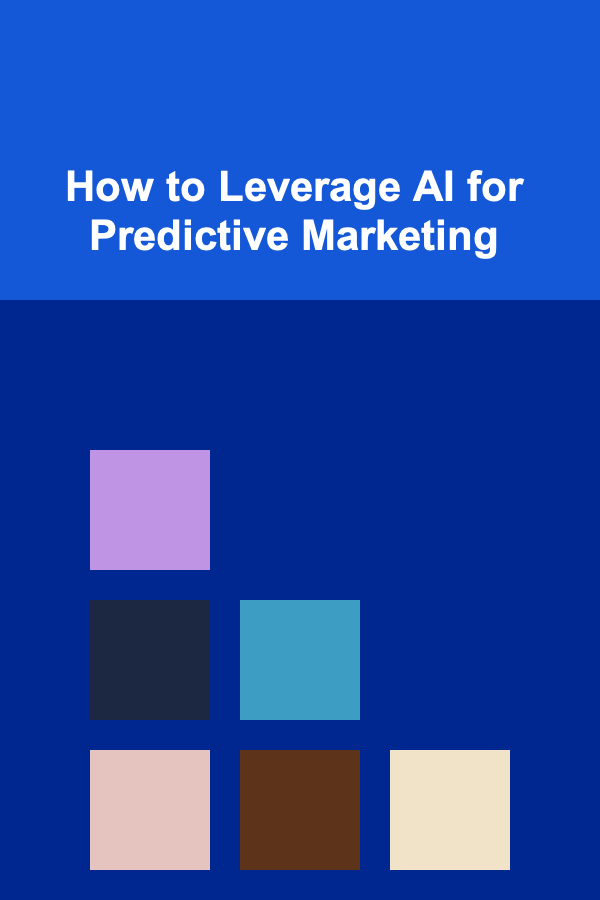
How to Leverage AI for Predictive Marketing
ebook include PDF & Audio bundle (Micro Guide)
$12.99$5.99
Limited Time Offer! Order within the next:

In recent years, artificial intelligence (AI) has rapidly transformed a wide range of industries, and marketing is no exception. AI has not only enhanced the personalization of customer experiences but also provided marketers with new tools to predict future trends, behaviors, and outcomes with remarkable accuracy. One of the most powerful applications of AI in marketing is predictive marketing, which uses historical data, machine learning, and predictive analytics to forecast customer behavior and optimize marketing strategies.
In this article, we will explore how AI can be leveraged for predictive marketing, its benefits, challenges, and best practices for integrating AI into marketing campaigns.
Understanding Predictive Marketing
Before diving into the specifics of how AI can be leveraged, it is important to understand what predictive marketing is. Predictive marketing refers to the use of data, algorithms, and machine learning to forecast future customer behavior. By analyzing past customer interactions, purchasing patterns, and demographic data, businesses can predict the likelihood of future events, such as a customer making a purchase, subscribing to a service, or disengaging with the brand.
Predictive marketing allows companies to move from reactive marketing to proactive marketing, where campaigns are not just based on past performance but are driven by data-driven predictions. This level of foresight helps brands deliver more relevant content, improve targeting, optimize resource allocation, and ultimately enhance customer satisfaction and retention.
Key Components of Predictive Marketing
- Data Collection: Predictive marketing relies on a vast amount of data, including transactional data, web behavior, social media interactions, and demographic information. AI systems use this data to create predictive models.
- Machine Learning Models: Machine learning algorithms, particularly supervised learning models, are used to identify patterns and trends in the data. These models are trained to predict customer behavior based on historical data.
- Predictive Analytics: This is the process of using statistical techniques and machine learning to analyze current and historical data and predict future trends. Predictive analytics in marketing typically focuses on customer acquisition, churn, lifetime value, and conversion rates.
How AI Enhances Predictive Marketing
AI offers several significant advantages in predictive marketing, making it an essential tool for businesses seeking to gain a competitive edge in the market. Let's examine some of the ways AI enhances predictive marketing:
1. Improved Customer Segmentation
One of the core tasks in marketing is segmentation, which involves dividing customers into different groups based on shared characteristics or behaviors. Traditionally, segmentation was based on broad demographic data or simple buyer personas. However, AI takes segmentation to the next level by analyzing vast amounts of customer data and identifying highly specific and nuanced patterns in customer behavior.
By leveraging AI, marketers can segment customers in real-time, dynamically adjusting the segmentation criteria based on new data inputs. AI-driven segmentation allows brands to target customers more precisely with personalized marketing messages, offers, and content that are tailored to their needs and preferences. This leads to improved conversion rates, higher customer satisfaction, and better ROI on marketing campaigns.
2. Accurate Demand Forecasting
AI is highly effective at predicting future demand for products or services. By analyzing historical sales data, seasonal trends, customer behavior, and even external factors like economic conditions or market shifts, AI models can forecast demand with remarkable accuracy.
For example, AI can predict when certain products are likely to experience a surge in demand, enabling businesses to optimize inventory management, production schedules, and marketing efforts. In e-commerce, this could mean predicting the right time to launch promotional campaigns or adjust pricing strategies to capitalize on an expected increase in demand.
3. Enhanced Lead Scoring and Conversion Prediction
In B2B marketing, lead scoring is a crucial part of the sales process. Traditional lead scoring methods often rely on simple criteria, such as demographic information or past interactions with the brand. AI, however, can assess a much broader set of variables and make predictions about which leads are most likely to convert.
AI-driven lead scoring uses machine learning algorithms to assess customer data, behavioral patterns, and engagement history to assign a predictive score to each lead. This enables sales and marketing teams to prioritize high-value leads and optimize their outreach efforts. Additionally, AI can predict the likelihood of a lead converting into a paying customer, allowing businesses to refine their marketing strategies for better results.
4. Personalization at Scale
Personalization is a cornerstone of modern marketing, and AI enables businesses to offer highly personalized experiences to customers at scale. Traditional personalization efforts often rely on basic segmentation or customer preferences, but AI takes personalization to a whole new level by leveraging advanced algorithms and real-time data.
AI can analyze individual customer behavior across multiple touchpoints, including website visits, email opens, social media interactions, and past purchases. Based on this data, AI can dynamically generate personalized content, product recommendations, and promotions that are highly relevant to each customer. This level of personalization not only increases the likelihood of conversions but also fosters long-term customer loyalty and satisfaction.
5. Predicting Customer Churn and Retention
Customer retention is one of the most significant challenges for businesses, especially in industries with high competition or subscription-based models. AI can help predict which customers are at risk of churning by analyzing behavioral signals and engagement patterns.
For example, AI models can identify warning signs, such as reduced interaction with emails, lower frequency of purchases, or negative feedback. Armed with this knowledge, businesses can take proactive steps to retain customers, such as offering targeted promotions, personalized content, or customer support outreach. Predicting churn and acting on it early can significantly reduce customer attrition rates and improve long-term profitability.
6. Optimizing Marketing Campaigns
AI-driven predictive marketing is essential for optimizing the performance of marketing campaigns. Predictive analytics tools can assess the effectiveness of marketing strategies by analyzing past campaigns and identifying which tactics were most successful. These tools can then forecast the outcomes of future campaigns based on various factors such as audience demographics, message timing, and channel choice.
AI can also help optimize campaign budgets by determining the most cost-effective strategies and channels for reaching specific customer segments. This optimization leads to higher ROI, reduced marketing waste, and more successful campaigns overall.
Implementing AI in Predictive Marketing
While AI offers immense potential for predictive marketing, integrating AI into marketing strategies requires careful planning and execution. Here are the key steps businesses can take to successfully implement AI-driven predictive marketing:
1. Gather High-Quality Data
The effectiveness of AI in predictive marketing is directly tied to the quality of the data used to train machine learning models. Marketers must ensure they are collecting accurate, comprehensive, and up-to-date customer data. This includes transactional data, website behavior, social media interactions, and any other relevant data points.
Additionally, businesses should invest in data cleansing and normalization processes to ensure that the data fed into AI systems is consistent and reliable. Poor data quality can lead to inaccurate predictions and suboptimal marketing strategies.
2. Choose the Right AI Tools and Platforms
There is a wide range of AI tools and platforms available for marketers looking to implement predictive marketing. These tools vary in terms of functionality, ease of use, and integration with other marketing technologies.
Some of the popular AI-driven predictive marketing platforms include:
- Salesforce Einstein: A powerful AI tool that offers predictive analytics, personalized recommendations, and lead scoring capabilities.
- HubSpot: An inbound marketing platform with AI-powered tools for lead nurturing, customer segmentation, and email personalization.
- Google Cloud AI: A suite of AI tools for building custom machine learning models, analyzing data, and making predictions.
- Predictive Analytics Tools: Standalone platforms like RapidMiner or IBM SPSS that provide advanced predictive analytics capabilities.
When selecting a platform, businesses should consider factors such as ease of integration, scalability, and the specific use cases they want to address.
3. Train Machine Learning Models
Once data is collected and AI tools are chosen, businesses must train machine learning models to make accurate predictions. Training involves feeding historical data into AI algorithms, allowing the system to learn patterns and relationships between different variables.
Machine learning models should be trained using relevant data from past campaigns, customer interactions, and purchasing behavior. Marketers should also use A/B testing and continuous monitoring to fine-tune the models over time and improve their accuracy.
4. Monitor and Refine Predictions
Predictive marketing is not a one-time effort. AI models need continuous monitoring and refinement to ensure that they remain accurate and relevant. Marketing teams should regularly evaluate the performance of their predictive models and adjust their strategies based on real-time data.
For example, if a predictive model is incorrectly forecasting demand for a particular product, marketers can adjust the model by incorporating new data or tweaking the algorithms. Ongoing optimization ensures that predictive marketing efforts remain effective and aligned with business goals.
5. Focus on Ethical Considerations
As AI becomes more integrated into marketing, ethical considerations become increasingly important. Marketers must ensure that AI models are used responsibly and that customer privacy is respected. This includes obtaining consent for data collection, being transparent about how data is used, and adhering to data protection regulations such as GDPR.
Furthermore, AI models should be trained to avoid biases that could result in unfair or discriminatory marketing practices. Regular audits and testing should be conducted to ensure that predictive models are equitable and unbiased.
Conclusion
AI is revolutionizing the way marketers predict and influence customer behavior. By leveraging machine learning, predictive analytics, and advanced data analysis, businesses can gain deeper insights into customer preferences, forecast demand, improve segmentation, and optimize marketing campaigns.
While the integration of AI into predictive marketing may seem complex, the benefits far outweigh the challenges. By using AI tools to collect and analyze data, train machine learning models, and continuously refine predictions, businesses can achieve higher conversion rates, improved customer retention, and a more personalized customer experience.
As AI technology continues to evolve, the potential for predictive marketing will only grow, enabling businesses to stay ahead of the competition and deliver exceptional marketing strategies that resonate with customers. Embracing AI for predictive marketing is not just a trend---it's the future of how businesses will interact with customers in a data-driven, highly personalized world.

Corporate Communication Specialist's Handbook: Navigating Internal and External Messaging
Read More
Effective Strategies for Reducing Car Maintenance Costs and Saving Money
Read More
How to Curb Impulse Spending: Tips for Reducing Impulse Buying
Read More
How To Master Time Management for Creative Professionals
Read More
How to Organize Medical Records for Easy Access
Read More
How to Use Mirrors to Make Your Home Look Bigger and Brighter
Read MoreOther Products

Corporate Communication Specialist's Handbook: Navigating Internal and External Messaging
Read More
Effective Strategies for Reducing Car Maintenance Costs and Saving Money
Read More
How to Curb Impulse Spending: Tips for Reducing Impulse Buying
Read More
How To Master Time Management for Creative Professionals
Read More
How to Organize Medical Records for Easy Access
Read More